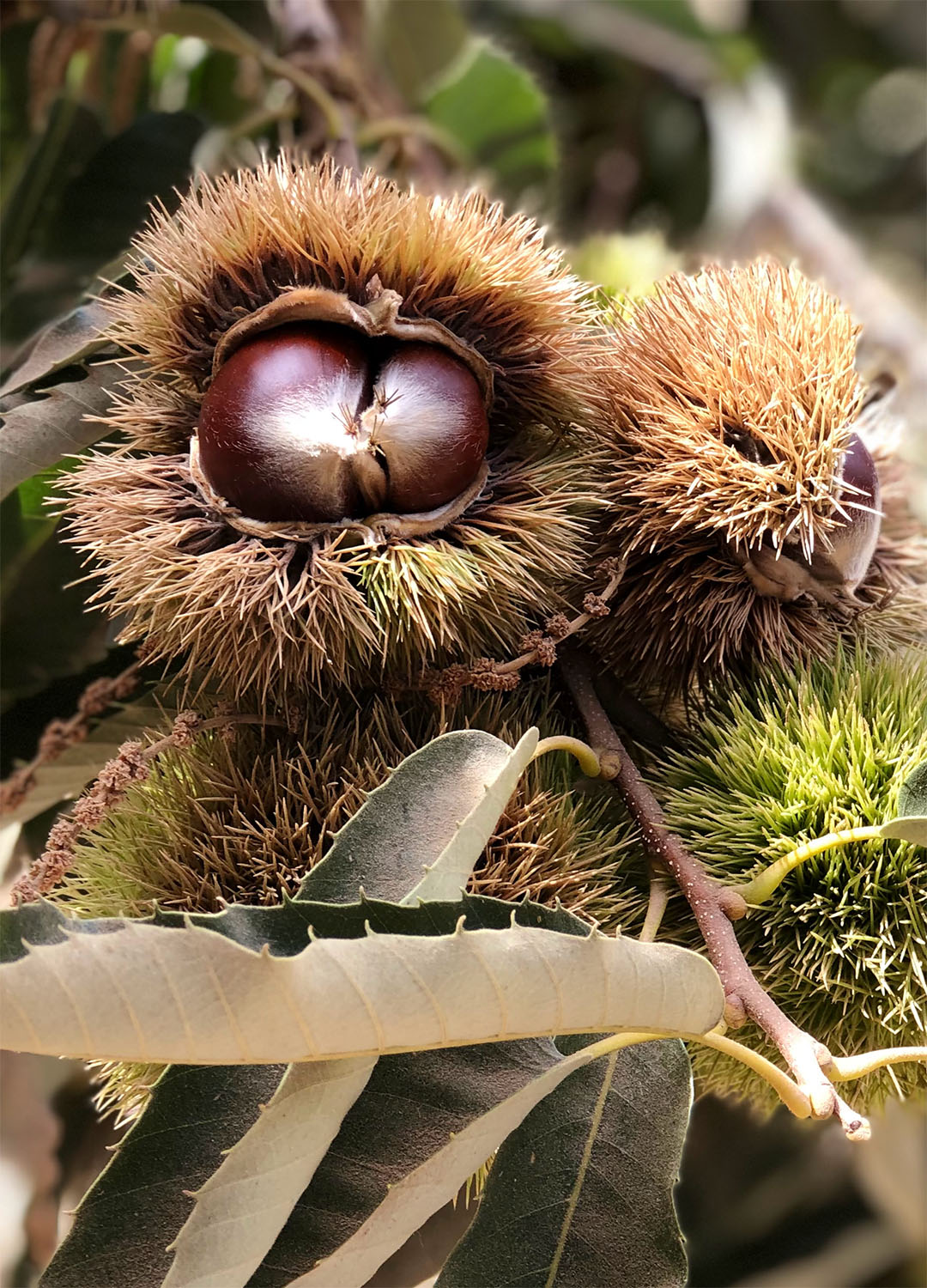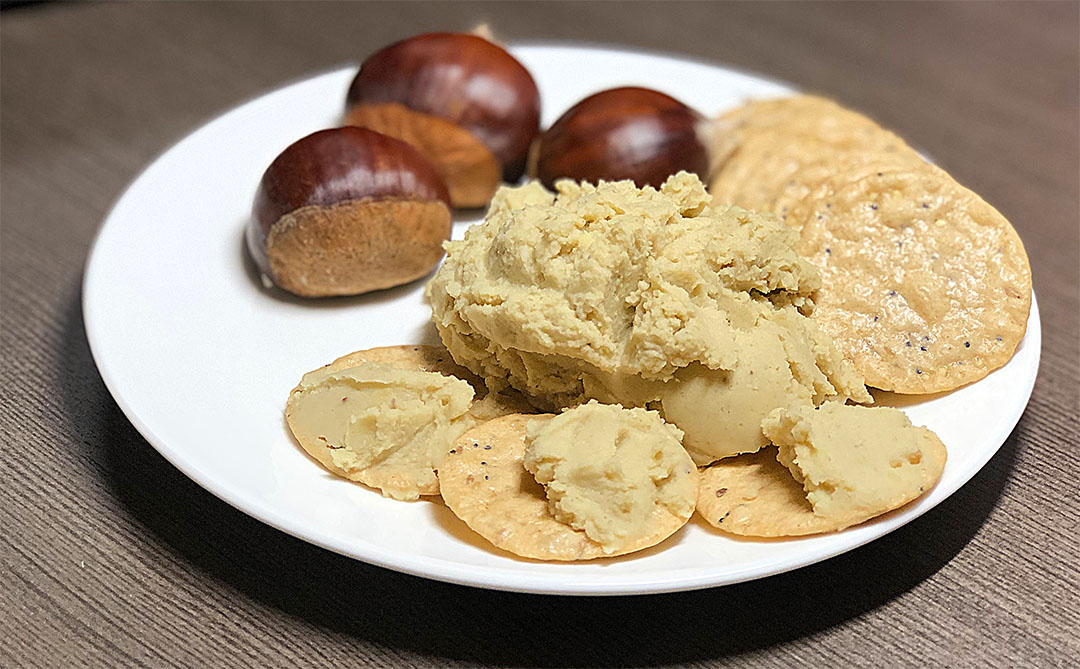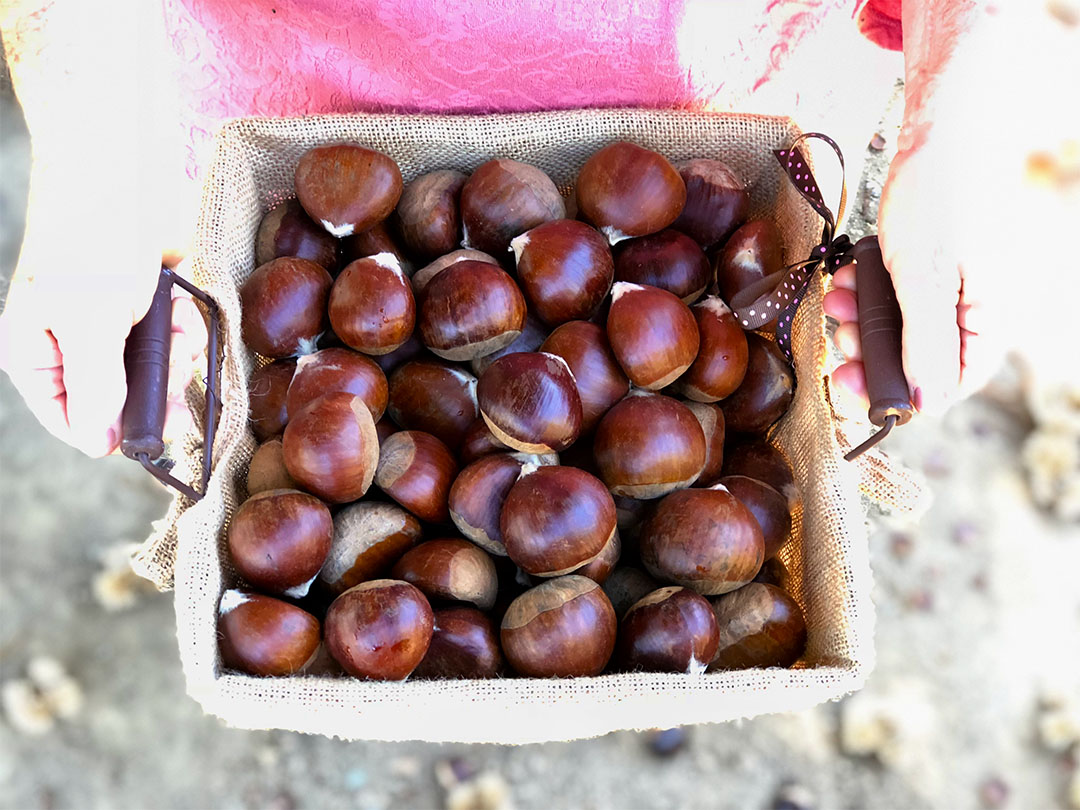How to find, prepare, and impress with fresh chestnuts this season.
Chestnuts roasting on an open fire? How passé.
It’s an endearing holiday song, indeed, yet seasonally incorrect when speaking of the visually appealing, scrumptious fruits of the chestnut tree. Their ruddy hue replicates the colors of autumn when they’re harvested. And roasting over an open fire is just one way to cook these earthy, sweet nuts that come in many varieties, each with its own distinctive qualities, much like apples.
With a sweet-potato- or roasted-carrot-like texture when cooked, chestnuts possess impressive nutritional content. Within that smooth shell, chestnut meat is high in fiber, complex carbohydrates, and vitamin C, along with being low in calories and 99 percent fat free, unlike its nut cousins.
While four overarching types of chestnuts are grown in the United States — American, Japanese, Chinese, and European — many amalgams exist on chestnut farms, which can be found around Northern California. Harrison’s California Chestnuts orchard in Gridley, Calif., primarily grows the colossal variety, a mouthwatering Japanese-European hybrid.
Owner of the orchard Sandy Harrison says, “The closer we get to September, I actually start to physically crave them.”
Preparing and eating harvested chestnuts can be an interactive experience. While Harrison cites a plethora of ways to prepare chestnuts, one of her favorites is roasting them with family, then peeling and eating the nuts together.
Chicken and chestnuts create a delectable melody on your palate, while the nuts’ creamy, rich flavor and texture shine in soups, and “chummus” (see recipe to follow). Added to a charcuterie plate, chestnuts can replace bread and crackers for people seeking low-carb or gluten-free snacks. Try squash stuffed with chestnuts and salmon topped with them. Or impress guests with a chestnut risotto.
Begin Your Chestnut Journey
Order them from a reputable local chestnut orchard — ideally, on weekends in October — and purchase them freshly harvested.
These perishable delicacies must be cured in the refrigerator after harvesting or they will mold. Keep them in a bag in the refrigerator, turning them every 24 hours.
Harrison suggests purchasing a chestnut knife, made specifically for easily scoring the nuts and usable by even young family members. Chestnuts must be scored prior to cooking to release the nuts’ moisture content and prevent them from bursting while cooking. Boiling and steaming are fast, efficient ways to cook them.

Once cooked, the shell and fibrous internal skin, called the pellicle, need to be removed before eating or adding to dishes.
Remember, if you’re singing the holiday song with chestnuts in hand, they’re far from fresh. Instead, relish the luscious nuts when they’re falling from the trees each fall.
Where to Find Them
- Though no chestnut farms can be found in Northern Nevada or the Lake Tahoe area, there are several in Northern California, just a few hours away.
- Order online or schedule a pickup of freshly harvested chestnuts at Harrison’s California Chestnuts orchard (com) in Gridley in September or October.
- Chestnut Growers of America (org/growers.html) provides a list of chestnut orchards in California and across the U.S.
Harrison’s Fresh Chestnut Soup
(courtesy of Harrison’s California Chestnuts in Gridley. Serves 4 to 6)
6 tablespoons unsalted butter, divided
1 pound raw chestnuts, peeled
1 carrot, peeled and sliced
1 parsnip, peeled and sliced (optional)
1 cup celery, finely chopped
6 cups chicken or vegetable broth
¼ cup Madeira wine
Pinch of nutmeg
Salt and pepper, to taste
2 sprigs fresh parsley, finely chopped
Pinch of cayenne pepper, or to taste
¼ cup sour cream or crème fraîche
Rinse fresh chestnuts in a colander with cool water.
Use a large, heavy knife to cut the fresh chestnuts in half. Carefully, place nuts in a pot of boiling water and cook 8 minutes. Remove from pot and place in a bowl of ice water. Ice water chills the nuts quickly and helps release their shell and inner skin (pellicle). Remove shell with a chestnut knife or paring knife and peel off pellicle.
Sauté fresh chestnuts in 3 tablespoons of butter over medium heat until heated through (about 5 minutes). Set aside.
In large saucepan, melt remaining butter and sauté carrots, parsnips, and celery until tender (about 7 minutes). Add the stock, prepared fresh chestnuts, and wine. Bring to a boil, then simmer 30 minutes; season with a pinch of nutmeg, and salt and pepper to taste. Purée the soup with an immersion blender, blender, or food processor.
Reheat as needed before serving. Garnish with parsley, cayenne pepper to taste, and sour cream or crème fraîche.
Chummus (aka chestnut hummus)
(courtesy of Harrison’s California Chestnuts in Gridley. Serves 4 to 6)

12 ounces cooked chestnuts (16 ounces raw)
1 clove garlic, chopped
cup tahini
1/4 cup fresh lemon juice
3/4 teaspoon ground cumin
1/3 teaspoon sea salt
1/8 cup extra-virgin olive oil
1/3 cup water
Dash of cayenne pepper (optional)
Rinse fresh chestnuts in colander with cool water. Use a large, heavy knife to cut fresh chestnuts in half. Carefully place nuts in pan of boiling water and cook 8 minutes. Remove them from pan and place in bowl of ice water. Remove shell with chestnut knife or paring knife and peel off pellicle.
Combine prepared chestnuts, garlic, tahini, lemon juice, cumin, sea salt, olive oil, and water in a food processor. Mix until smooth. Add extra water for desired consistency.
Serve in a bowl, and garnish with thinly sliced carrots, red onions, and whole cilantro leaves. Drizzle extra-virgin olive oil over chummus, carrots, and onion, then top with cilantro. Serve with rice crackers or pita bread (sliced and warmed).


